auf anzeigen
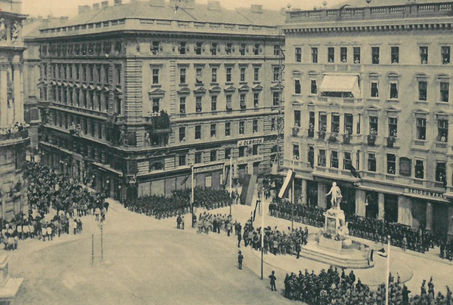
A lot of what Vienna is famous for today, such as the Vienna State Opera, Albertina museum or the Ring Road, did not yet exist when Georg Pöhlein opened a coffee house in the so-called Bürgerspitalzinshaus. Opposite, on the ruins of the old town fortifications, the Palais Taroucca, is situated since 1745. Here, Duke Albert of Saxony-Teschen, a son-in-law of empress Maria-Theresa, housed his art collection from 1805 onwards. From that, the present Albertina graphic collection, one of the world's most important collections of art - a splendid vis-à-vis for our guests - developed.
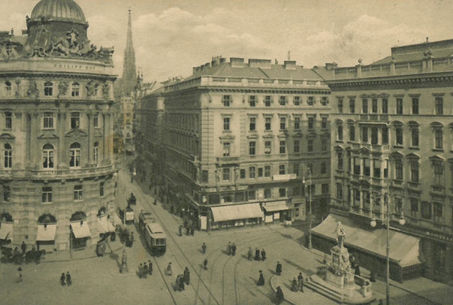
After several changes of ownership, the coffee house experienced its first blooming period under Simon Corra. He had it renovated in 1836, and his Café Corra soon became one of the most important coffee houses in Vienna. Particularly beneficial to this success was the Schanigarten established by Corra, which he furnished with tables, chairs, umbrellas and pot plants. Just around the corner, where today the Hotel Sacher is situated, you could find the Kärntnertortheater. Many actors and their audiences visited Café Corra and its attractive Schanigarten.
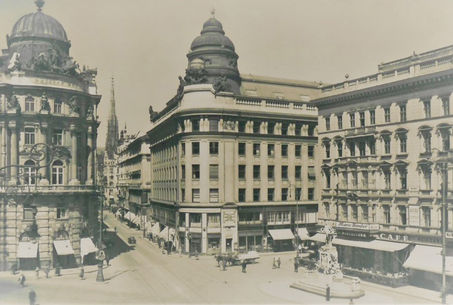
Mr. Katzmayer bought the coffee house and redesigned it with a lot of marble, mahogany and upholstery of red and green velvet. As Café Katzmayer it became one of the most important Viennese coffee houses and was the meeting place for journalists, literati and artists. This intellectual audience called for the police to act as informants for Chancellor Metternich. Today such eavesdroppers would not have a chance. Café Mozart emphasizes discretion and privacy. After the K & K Hofoper was opened next door in 1869 with Mozart's "Don Giovanni", the Kärntnertortheater was torn down to make way for Sacher. In 1882 the Bürgerspitalzinshaus along with Café Katzmayer also had to give way. Many houses, streets and alleyways were erected on this huge area. The Café Katzmayer was successfully reopened in the newly erected, presently historic building, on the corner of Maysedergasse/ Albertinaplatz. Members of the philharmonic orchestra and opera ballet and singers were among the regular guests.
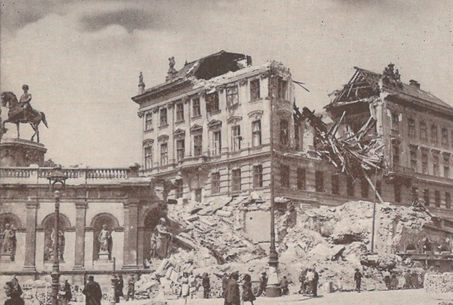
The family of café house proprietor, Oskar Hornik, purchased the coffee house and named it after the Mozart monument at the Albertinaplatz, which today can be seen in the Burggarten. Café Mozart flourished. But after the "union" in 1938 the Jewish owner Oskar Hornik was forced to sell the place at a much too low price and it was Arianised. Shortly before the end of the war the area around the Albertinaplatz was almost completely destroyed during heavy air raids, including the Albertina and the State Opera. At the former location of the bombed-out Philipphof, a large apartment building opposite Café Mozart, the "Memorial to War and Fascism" today remembers the victims of National Socialism.
After the restitution of the coffee house to the Hornik family, is was difficult to start again. People fought for survival. The café developed into a base for value traders, inspiring the writer Graham Greene to work on his novel "The Third Man". Greene also wrote the screenplay for the legendary film adaptation of director Carol Reed, who was shot in 1948 with Orson Welles and Joseph Cotten in the main roles. They all lived next door in the Hotel Sacher, but spent a lot of time in Café Mozart. Carol Reed fell in love with the coffee house, so he desperately wanted to have it as a film location. Anton Karas, who played the world-famous "Harry Lime Theme" on his cittern, even composed his own "Cafe Mozart Waltz", with which the Schanigarten-scene in the film is highlighted. With the reconstruction of Vienna, Café Mozart was also restored and subsequently managed by the Hornik-family for decades.
The Japanese department store chain, Mitsukoshi, bought Café Mozart to operate it as a high-end café, but failed. Perhaps the accessibility to all people, which characterizes a real Viennese coffee house, was missed too much.
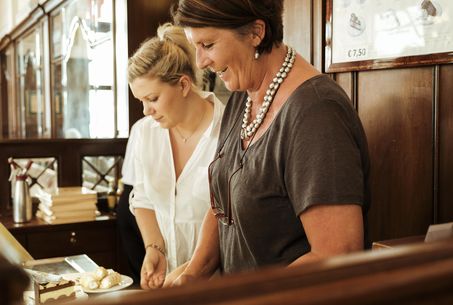
During this year the Querfeld-family took over the coffee house. Under the direction of senior partner, Anita Querfeld and her daughter Andrea Winkler, it was lovingly renovated to bring back the traditional spirit that is typical of the Viennese coffee house. Since then the Café Mozart has developed into a cosmopolitan and lively meeting place in the center of Vienna, which is appreciated by all guests. Andrea Winkler and her daughter Karoline Klezl manage it with great joy and appreciation for this treasure, which they preserve and manage diligently.
auf anzeigen